|
USENIX 2003 Annual Technical Conference, FREENIX Track — Paper
[USENIX Annual Conference '03 Tech Program Index]
| Pp. 29-38 of the Proceedings | |
U-P2P: A Peer-to-Peer Framework for
Universal Resource Sharing and Discovery
Neal Arthorne, Babak Esfandiari, Aloke Mukherjee
Department of Systems and Computer Engineering
Carleton University, Ottawa, Ontario, Canada
narthorn@connectmail.carleton.ca
babak@sce.carleton.ca
alokem@cisco.com
Abstract:
We present U-P2P, an open source framework for developing,
deploying and discovering file-sharing communities.
We address the problem of search in peer-to-peer file sharing
by allowing the end user to add metadata to shared documents.
Each file-sharing community allows the sharing of a particular structured document type.
Communities are themselves modeled as structured documents,
thus enabling their sharing and discovery just like any other document.
The creator of a particular community specifies, among other properties,
the document type that it shares and the deployment model.
U-P2P's extensible architecture allows developers to create new
properties or extend existing ones. For example, developers can provide new deployment
models or custom privacy and authentication features. U-P2P makes use
of other open source projects such as Jakarta Tomcat and eXist, an XML database system.
The current success of peer-to-peer (P2P) file sharing
applications has highlighted the benefits of resource distribution and
redundancy. However, to truly exploit such
advantages, a few roadblocks remain to be cleared. In particular,
search and discovery of resources is still quite difficult. Most
known approaches rely on simple schemes such as a search for the
resource name or type. File sharing communities are most efficient
when the name of the file carries most if not all of the needed
information. As a result, most file swapping communities are
restricted to swapping music and video files. Even when the
exchange of non-music files is possible, the difficulty of finding
such files has been a sufficient deterrent. Lack of metadata is
the main problem.
Another roadblock to more general applications of P2P has been the
difficulty of creating communities for specific purposes. This
arises partially from the difficulty of defining custom metadata
about different types of files. Another important problem is the
current fractured state of peer-to-peer communities. Again, the
lack of metadata about communities makes it difficult to know what
there is to look for in the first place.
We propose a peer-to-peer framework called Universal Peer-to-Peer
(U-P2P) that simplifies the sharing of custom metadata formats as
well as the easy creation, configuration and discovery of
peer-to-peer communities. In U-P2P, each community is described in
part by the metadata of the files it exchanges. The format of a
community's metadata is specified using the XML Schema language,
allowing new communities centered on that file type to be
created in any text editor. U-P2P allows these custom resources to
be created and shared as in traditional file-sharing services.
By logical extension, the description of the community itself (the
metadata format of its files, the protocol used for search, etc)
is encapsulated in an XML file. In U-P2P, creating, sharing or
discovering a community follows the same principles as creating,
sharing or discovering a file within that community. As a result,
file-swapping communities such as Napster or Kazaa can be seen as
instances of U-P2P devoted to sharing a few specific file
types and utilizing a given P2P protocol.
Our focus is on the discovery problem in peer-to-peer systems. In
Napster [1], the only files that could be shared on the
network were MP3 audio files. Search was based on filenames and
relied on users encoding the artist and title of each song in the
MP3's title. Although metadata such as encoding rate could be used
to sort the results, there was no way to search on these metadata
or define other parameters. On a Gnutella [2] network,
any type of file can be shared: however there is no explicit
metadata handling. Search strings are passed around without
processing between peers and their interpretation is left to the
peer. Each peer must implement its own search algorithm using the
search string as input. Most Gnutella implementations, like
Napster, simply return filenames that contain the search string.
Gnutella does permit the design of overlay protocols to encode and
decode metadata from search strings. Some Gnutella developers have
proposed using this approach for richer metadata searches.
[3,4]. Schemas are defined for common file
types: for example an audio file might be defined to have
properties such as artist, title, bit rate, album, etc. The schema
defines a structured format for searching MP3 metadata that is
sent as a search string to other Gnutella nodes. Responding
clients use the query to search local files annotated using the
schema and returns the results using the same structured format.
In practice though, all members of a given community must be able
to speak a common language in order to communicate.
Other P2P systems such as FastTrack [5], Opencola
[6] or Bitzi [7] propose variations on that
idea, but they are still limited to a number of predefined
schemas. The latter two have the capability to extract metadata
information from a file given the file format, but this is only
possible for certain formats.
Clearly, there is a need for shared ontologies if we want
to allow search for any type of file. In the Internet world, the
XML Schema format[8] is the current choice to
represent ontologies, replacing Document Type Definition (DTD)
[9], the schema language defined in the original XML
specification. XML Schema supports the creation of custom and
complex data types for XML tags, which is essential to describe
aggregated or composite resources. For richer semantic
descriptions, for example to allow software agents to perform
search instead of humans, there can be a need to describe
relationships between resources. RDF [10] and more generally
the Semantic Web [11] effort address that need. The
Edutella project [12] is a technology for distributed
learning that uses a P2P network for sharing RDF-formatted
metadata. However in Edutella metadata is the resource, not the
means to describe one.
A P2P system using a semantic layering approach is not without its
drawbacks. First and foremost is getting users of the system to
supply metadata for their resources. The addition of metadata
requires user-friendly tools for authoring RDF and schemas and a
simplified approach for users who are not familiar with XML
languages.
What we propose in U-P2P starts, as in Edutella, with the sharing
and discovery of metadata described this using XML Schema.
Once metadata is discovered it is used to instantiate a particular
resource, which is in turn shared. The next section gives a
high-level description of the principles behind U-P2P as well as
its design.
U-P2P relies heavily on XML Schema and the following sections
include some examples of XML Schema and a brief
description of the structure of XML Schema documents.
XML Schema is a Recommendation [8] by the World Wide
Consortium for a schema language for XML. It constitutes a set of
markup tags themselves written in XML, that are used to describe
both the structure of an XML document and the datatypes of
individual elements and attributes. XML Schema uses the XML
Namespace Recommendation that allows authors to prefix their own
tags with a specific namespace. It also allows importing types
from other schemas both in the current namespace and from other
namespaces.
XML Schema can be used to validate XML documents using a schema
processor. XML documents themselves can link to their schema using
a schemaLocation tag. However this is only a suggested method for
specifying a schema for the document and they may use other types
of schemas such as DTDs or not require validation at all.
In XML Schema, there are four basic units that can be used to
describe parts of an XML document: elements, attributes,
simpleTypes and complexTypes.
Elements - Elements are the tags used in XML to label a
piece of data. They have a datatype associated with them that is
either defined at the same time as the element (anonymously) or is
a complexType or simpleType. Elements can contain subelements,
attributes and can also be part of an XML Namespace. The structure
of an element can be controlled in XML Schema using sequences,
choices and the same restrictions used to derive simple and
complex types. For example an author can specify that an element
called 'name' should consist of an exact sequence of the two
elements 'firstname' and 'lastname'.
Attributes - Attributes are properties that belong to a
parent element. They can only use simpleTypes and they cannot
contain any elements or attributes. Attributes can be optional or
mandatory within an element.
Simple Types - These types are either built-in data types
specified in the XML Schema Recommendation or Simple Types derived
from the built-in or existing types (XML Schema defines some
derived types such as date and time). The Recommendation includes
many useful data types such as string and decimal, that can easily
be manipulated into more specialized Simple Types.
Complex Types - These types are a sequence or choice
between a set of elements and/or attributes. They are reusable
(when defined on a global level) and can be used in any part of
the current schema. Once a Complex Type is defined an element can
use it by specifying the type attribute equal to the name of the
Complex Type. An example of a Complex Type follows:
<xsd:complexType name="CanadaAddress">
<xsd:sequence>
<xsd:element name="street" type="xsd:string"/>
<xsd:element name="city" type="xsd:string"/>
<xsd:element name="postalCode">
<xsd:simpleType>
<xsd:restriction base="xsd:string">
<xsd:pattern="\w\d\w\s\d\w\d"/>
</xsd:restriction>
</xsd:simpleType>
</xsd:element>
<xsd:element name="province" type="xsd:string"/>
<xsd:element name="country" type="xsd:string"
fixed="Canada"/>
</xsd:sequence>
</xsd:complexType>
An example conforming to this schema:
<CanadaAddress>
<street>1125 Colonel By Drive</street>
<city>Ottawa</city>
<postalCode>K1S 5B6</postalCode>
<province>Ontario</province>
<country>Canada</country>
</CanadaAddress>
Having defined the above example, the type can then be used in an
element anywhere in the schema or even referenced from other
schema.
XML Schema is powerful enough to describe any complex XML
structures and the support for data types means the contents
of shared documents are validated using the lexical representation
of the data. When sharing large volumes of documents, it is useful
to have full validation at the entry of the system as this will
prevent the spread of unstructured data that can't be properly
searched and indexed.
U-P2P provides four fundamental services: search, create,
browse local and view. Each of these services are provided
in the context of a community. We can imagine the existence of a
"stamps" community that trades pictures and descriptions of stamps
from around the world. On entering the stamp community the U-P2P
Search function offers fields to search for stamps of a given
year, and/or from a given country. Similarly, the Create function
prompts you to upload a picture of the stamp, Browse Local shows
the stamp objects that you have already downloaded and View
displays a picture as well as the attributes for one of your
downloaded stamps.
In traditional P2P applications this functionality would require
downloading a client that knows about the format of a stamp object
and contains customized search, create and view screens for such
an object. In U-P2P, we use the power of metadata to simplify this
task. Consider the following XML schema describing a stamp object:
<?xml version="1.0"?>
<xsd:schema xmlns:xsd="http://w3.org/2001/XMLSchema">
<xsd:element name="stamps">
<xsd:complexType>
<xsd:sequence>
<xsd:element name="name" type="xsd:string"/>
<xsd:element name="desc" type="xsd:string"/>
<xsd:element name="picture" type="xsd:anyURI"/>
<xsd:element name="country" type="xsd:string"/>
<xsd:element name="year" type="xsd:string"/>
</xsd:sequence>
</xsd:complexType>
</xsd:element>
</xsd:schema>
The schema above describes the expected elements of a stamp object
and their data types. It is possible to generate a form from this
specification using XML Stylesheet Language Transformations (XSLT)
[13]. Here is an excerpt from a stylesheet that generates a
search form from the above XML schema:
<xsl:template
name="SchemaTemplate"
match="*[local-name()='schema']">
<h3>Search for a Resource</h3>
<p>Enter keywords in any of the fields
below to perform a search.</p>
<form action="search" method="post">
<table border="1" cellpadding="5" cellspacing="0">
<tr><th>Property</th><th>Value</th></tr>
<xsl:for-each select=
"descendant::*[local-name()='element'
and count(./child::*) = 0]">
<xsl:call-template name="ElementTemplate"/>
</xsl:for-each>
</table>
<p><input type="hidden" name="up2p:community">
<xsl:attribute name="value">
<xsl:value-of select="$communityName"/>
</xsl:attribute>
</input>
<input type="submit" value="Search"/></p>
</form>
</xsl:template>
Similarly, stylesheets can be produced that render Create forms or
display a stamp object. With nothing more than a few XML documents
(a schema and stylesheets for creating, searching and displaying),
it is possible to define a whole new P2P file-sharing application!
In fact, U-P2P provides default stylesheets for handling display
and forms for resources made up of common types, making the
transformation processes transparent to the novice user. Figure
1 shows the relationships between the U-P2P functions,
and how they are accessed through XSL transformations.
Figure 1:
Generation of resource-specific displays
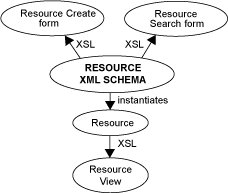 |
So how can a stamp community be found or shared in the first
place? The idea in U-P2P is to see a file-sharing community as
just another type of resource. This is analogous to the idea of a
class in object-oriented programming which specifies the structure
of objects. In pure object-oriented languages such as Smalltalk, a
class is merely another type of object whose structure is
specified by a metaclass. Traversing the analogy in the opposite
direction, a specific U-P2P community can be seen as a class
instantiated by a more general metaclass: a
Community-sharing community (in short: a community community)
shares Community objects:
- an object is an instance of its class, which
is an instance of its metaclass
- mp3 belongs to
mp3 community, which belongs to community community
In U-P2P the problem of discovering the existence of a community
is thus reduced to the problem of finding an object. This provides
a standard way to discover the existence of resource-sharing
communities.
To facilitate this, U-P2P comes packaged with one "bootstrap"
schema that can be used to search for and more importantly create
communities:
<?xml version="1.0"?>
<xsd:schema
xmlns:xsd="http://www.w3.org/2001/XMLSchema">
<xsd:element name="community">
<xsd:complexType>
<xsd:all>
<xsd:element name="displayLocation"
minOccurs="0" type="xsd:anyURI"/>
<xsd:element name="searchLocation"
minOccurs="0" type="xsd:anyURI"/>
<xsd:element name="createLocation"
minOccurs="0" type="xsd:anyURI"/>
<xsd:element name="schemaLocation"
type="xsd:anyURI"/>
<xsd:element name="name"
type="xsd:string"/>
<xsd:element name="category"
minOccurs="0" type="xsd:string"/>
<xsd:element name="keywords"
minOccurs="0" type="xsd:string"/>
<xsd:element name="description"
minOccurs="0" type="xsd:string"/>
<xsd:element name="protocol"
minOccurs="0" type="protocolType"/>
</xsd:all>
<xsd:attribute name="title" type="xsd:string"/>
</xsd:complexType>
</xsd:element>
<xsd:simpleType name="protocolType">
<xsd:restriction base="xsd:string">
<xsd:enumeration value=""/>
<xsd:enumeration value="Generic Central Server"/>
<xsd:enumeration value="Gnutella"/>
<xsd:enumeration value="JXTA"/>
</xsd:restriction>
</xsd:simpleType>
</xsd:schema>
As can be seen, a community can have many attributes: keywords,
deployment protocol, security... This means that a community can
be created by choosing specific values for such attributes (e.g.
keywords: stamps, Canadian; deployment: Napster-style…).
The search for a community is made in similar fashion, by filling
out a similar form. As of now however, we only provide one type of
deployment protocol, "Napster-style", in which the peer that
creates the community also acts as a broker. Other deployment
models, such as "Gnutella-style" (no broker required) and
"centralized repository" (a client-server option with no local
copies of files) are currently being developed. This means that
searching for a document could either be completely decentralized,
or that on the other extreme full persistence of files could be
assured by a central storage of files. Deployment decisions are
thus left entirely up to the creator of the given community. Also,
we have not yet explored various security or privacy schemes. Such
possibilities are discussed later in this paper, in the section on
design. The modular aspect of our design should hopefully allow
the open source development community to provide support for many
more of these attributes.
The schema combined with default stylesheets as described above
allow U-P2P to become an engine for creating and searching for
communities which trade all sorts of different types of files. A
stamp collector using U-P2P for the first time will go to the
community search form and type "stamp" into the keyword field.
Upon finding a community of collectors, he or she might download
the community including the community's schema and stylesheets.
U-P2P then offers the option of entering the community. Once in
the community the collector can perform all the actions one would
expect of a file-sharing application devoted specifically to
sharing stamps.
Figure 2 shows snapshots of a stamp view, a stamp search
form and finally the root community view, the highest level of
abstraction in U-P2P.
Figure 2:
The "stamps" community
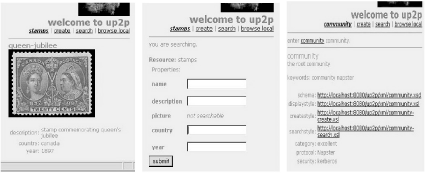 |
5 U-P2P Architecture and Design
Like other file-sharing services, U-P2P consists of a client and a
file server running on a user's computer. The client part of U-P2P
is implemented using Java Server Pages (JSPs)[15] running on
a local web server. The prototype uses Jakarta Tomcat
[16], but any server capable of serving JSPs may be used.
The user connects to the U-P2P network by pointing their browser
at the address of the local web server, typically
localhost:8080. The web server acts as GUI, and
dispatches search and create requests to the other
peers. In the current prototype, U-P2P follows the Napster model.
This means that there is also a central server that acts as a
database for information about all shared objects in the system.
As with Napster, the information about the location of files is
stored centrally but file transfers are conducted between peers.
We are considering other possible peer configurations, such as the
Gnutella distributed model and a hybrid one like FastTrack.
U-P2P consists of three major components shown in 3: the
WebAdapter, PeerNetworkAdapter, and the Repository. These
components form the core of U-P2P and provide all the services
needed to share and discover resources on a Peer-to-Peer network.
Figure 3:
The U-P2P Architecture
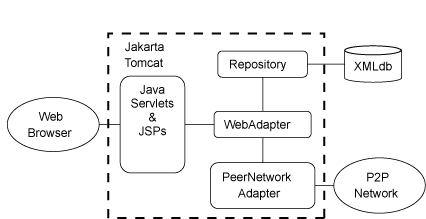 |
WebAdapter - Glues the components together and provides a
single point of access for the user interface. This component
currently supports a browser-based GUI, but could be replaced for
alternate GUIs.
Repository - Stores all shared XML resources in a
persistent XML database (using the XML:DB Database API
[17]) and provides local search capabilities to the
WebAdapter and the PeerNetworkAdapter. This allows for distributed
P2P topologies: each node must be able to execute searches against
its own set of shared resources.
PeerNetworkAdapter - Provides an interface to the
underlying Peer-to-Peer network and is responsible for servicing
search requests, publishing resources and downloading resources
from the network.
The above components are modeled as Java interfaces, with their
implementations as DefaultWebAdapter, DefaultRepository and
GenericPeerAdapter respectively. Additional classes include:
FileMapper - Maps resource IDs to real files on the local
file system. When a file is 'uploaded' it is assigned an ID and
mapped without modifying the file. The FileMapper is persistent in
case of shutdown of the U-P2P client and file mappings are
restored on startup.
FileMapEntry - Holds a reference to a resource file and
all its attachments, pulled from the resource in the upload
process. Attachment names must be unique within a resource.
Resource IDs are generated from the content of the XML file using
an MD5 hashing function. When hashing, a special ResourceProcessor
is used that omits any attachment links within the XML. This
allows the hash to stay consistent when the links are changed by
another peer upon download of the resource.
BasePeerNetworkAdapter - A skeleton class that holds a
reference to a DefaultRepository and implements the accessor for
the repository. The GenericPeerAdapter is the generic P2P
implementation included with U-P2P, which follows a Napster-type
model. Any developer wishing to provide an alternative
peer-to-peer deployment, such as a fully distributed one, or one
that would plug into an existing network, would have to provide a
different adapter.
DatabaseAdapter - Performs the dirty details needed to
get an XML database up and running and to configure the port that
it runs on. The current implementation uses eXist 0.8, an open
source XML database [18]. If a switch were made to a
different XMLdb implementation, this class would be sub-classed or
replaced.
The class diagram in figure 4 illustrates the
relationships between these classes.
Figure 4:
U-P2P core classes
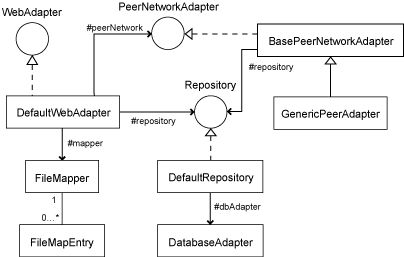 |
The web-based user interface requires that dynamic pages be served
up to the user for such activities as Search, Create
and View. The general flow of events that occur in one of
these activities involves the user accessing a JSP, the JSP
submitting a form to a Servlet and the Servlet talking to the
WebAdapter and then returning through a JSP.
Figure 5 shows the pages and Servlets involved in each
activity as well as the two extra Servlets needed for diagnostic
reasons and for servicing download requests.
Figure 5:
U-P2P Servlets
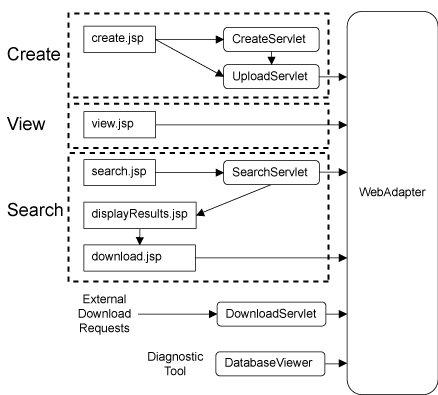 |
In peer-to-peer systems, data integrity, authentication and
authorization are concerns that are shared with other network
communication systems. In U-P2P we are concerned with a layering
of meta-data that is used on top of an existing network that may
or may not be secure. For this reason, the bulk of security
measures are left up to the network adapter used to communicate
with the underlying network. Each peer network has its own
requirements for security. Thus it would not be suitable for U-P2P
to impose a minimum level of security for all networks using the
U-P2P layering: this would restrict the ability to join public,
non-secure networks such as Gnutella or Freenet. Instead, it is up
to the founder of a community to decide which network adapter to
use: the level of security provided by the adapter will then be
used in all network communication.
It is reasonable to assume that a set of standard adapters could
be made available alongside a secured version of each adapter. The
currently available centralized peer-to-peer adapter could for
example, communicate through Secure Sockets Layer SSL [19]
channels and wrap all XML resources with an XML Signature
[20]. This would ensure that the content of the resources
have not been tampered with while in transit or when shared by
another user. The current Tomcat 4 platform used by U-P2P has full
provisions for SSL communication, but the current release of U-P2P
is not secured. U-P2P also uses the Java Servlet standard that
provides role-based security suitable for deployment and
integration with existing infrastructure.
It should be noted that the current implementation of U-P2P uses
MD5 sums to generate a unique ID when a resource is first uploaded
to the network. This ID is not intended for security purposes, but
as a simple means to check if multiple users are sharing the same
resource. In a future release of U-P2P, the core of U-P2P could
make use of the MD5 sum and XML Signatures for integrity and
authentication of shared resources, with the security of
communications remaining in the network adapter.
Two separate case studies have been developed to study the
usefulness and the performance aspects of U-P2P. The first case
study attempts to solve the known problem of searching for design
patterns. However, as the number of design patterns that are
properly documented and formatted is not sufficient to observe the
behavior of U-P2P under high load, another series of tests were
run using the Genome database.
The Carleton Pattern Repository [21] was started in 1999.
It served as a repository for software design patterns and
provided extensive search capabilities over a small list of
patterns. The patterns were represented in XML using a DTD
designed especially for the repository project [22].
The original pattern repository project included plans to
expand the repository to a distributed model.
The distributed model proposed was for each author group to have a
repository server with a fixed list of the other servers in the
network. The servers would form a highly distributed mesh and send
out their searches to all other servers. This model was not
implemented and evidently, no one else has pursued the idea.
Using the DTD as a basis, we have developed an XML Schema for
representing design patterns [23]. This is used as the
basis of a file-sharing community for design patterns. In addition
to the schema a custom stylesheet is required to render this
complex object since the default stylesheet is tailored to simpler
formats. Another design problem is deciding which parts of the
design pattern should be indexed. For simplicity, our current
implementation of U-P2P uploads the entire XML pattern file to make
it fully searchable.
To our knowledge, prior to our work there has been no way to share
design patterns in a peer-to-peer fashion that incorporates
meta-data search. When fully implemented this U-P2P based system
will expand the benefits of peer-to-peer file-sharing to this
area. Such a system would allow computer scientists and students
to publish a rich collection of patterns into an underlying
peer-to-peer network, search them using rich queries and replicate
popular patterns to increase their accessibility. The
community-discovery aspect could also be used to access
sub-communities devoted to different classes of design patterns or
based on different underlying networks.
A performance evaluation was made using a client and server
running on a single computer. The performance characteristics for
creating objects and searching were measured. Running on the same
node removed the effect of network latency and emphasizes the
delays incurred by the software and the XML database. There were
two major challenges to measuring U-P2P's performance
characteristics. The first challenge was having multiple
communities, each with a large collection of objects. The second
was automating the process of publishing and searching for
objects.
Creating a community and populating it with files manually was too
time-consuming so we sought out archives containing large numbers
of XML objects. One example of such a repository can be found at
the Berkeley Drosophila Genome Project (BDGP) [24] This
project maintains a database of annotations of different parts of
the Drosophila (fruitfly) genome. The project makes these
annotations available in different forms including as a large XML
file. This file is split such that each annotation was stored in
an individual file. Another pre-requisite for U-P2P communities is
a valid XML schema. As with many existing XML repositories, the
BDGP repository is described using the older DTD technology. This
has been transformed into XML Schema with the help of the dtd2xs
[25] package.
Although the BDGP collection was not intended for a peer-to-peer
environment, it does present one possible peer-to-peer
application. The BDGP is part of FlyBase, a distributed project
involving scientists at many different institutions. Each
annotation contains a collection of information that can be
enriched as information is gathered. With U-P2P each institution
(or even each scientist) could maintain their own local database
of annotations. By searching on a specific gene's name these
multiple annotations could be discovered, viewed and dynamically
reconciled, rather than requiring curation of each annotation at a
central repository.
Manually publishing and searching for large numbers of files was
not practical, so these operations were automated. An XMLRPC
interface was designed for the publish function. A command-line
XMLRPC client was written to take advantage of this capability
allowing the rapid addition of multiple objects. Search used a
different approach, relying on the URL to encode an XPath search
expression for a servlet designed to handle XPath formatted
queries. These two command-line tools can then be used to script
more complex experiments.
The time to publish and search was measured as repository size
increases. One hundred files were published to the Fruitfly
Community. Measurements are shown in Figures 6 and
7. 6 shows that publishing time increases in a
linear fashion with number of files created. A set of fifty search
queries was executed after one hundred files were added to the
community. The same queries were repeated every one hundred files,
up to fifteen hundred files. Finally each set of fifty execution
times for various search queries was averaged and plotted versus
the number of files. Figure 7 illustrates that the
initial publishing of objects is costly: two orders of magnitude
slower than the steady state time to publish. An explanation for
this is the overhead required to create a new collection, a new
object and whatever other internal data structures are used by the
XML database. Eventually this time settles down to a steady state.
On a Pentium 4 system this value was 1s.
Figure 6:
Evolution of search time based on community size
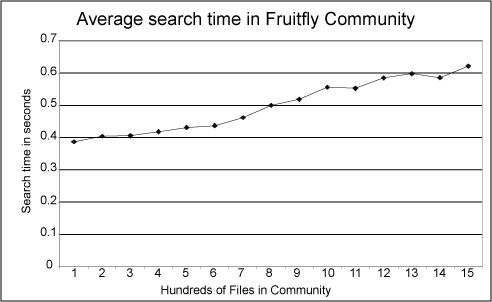 |
Figure 7:
Time to publish based on community size
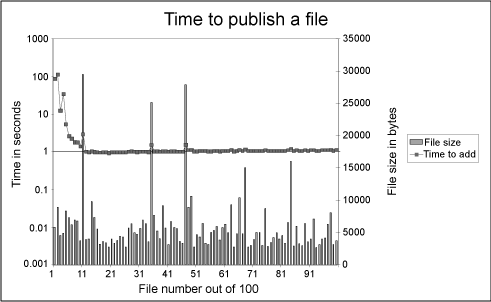 |
Another interesting set of experiments was performed to determine
whether publish and search times are affected by the presence of
other communities. The first experiment 8 measures the
time to add the first 10 files to a community as the number of
existing communities is increased from none to three. Each
community was created using 100 or so objects: the Fruitfly
community was then created and the time to add the first 10 files
recorded.
Adding a file when there are no published objects incurs a
performance penalty but these quickly converge to the 1s figure
mentioned previously. Adding the first object to a community in
the presence of other communities does not incur this penalty.
Publishing times for objects in the new community are comparable
to the time it would take to add more objects to one of the
existing communities. This indicates that it is the total number
of objects in the system and not the number of objects in a
community which determines how long it will take to publish a new
object.
Figure 8:
Time to publish when increasing the number of communities
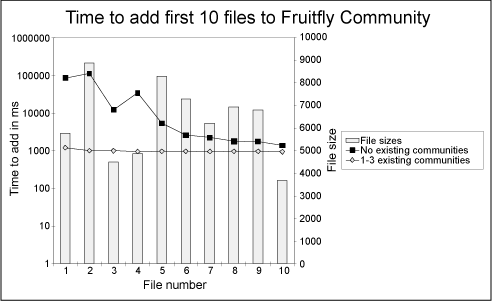 |
Figure 9:
Search time when increasing the number of communities
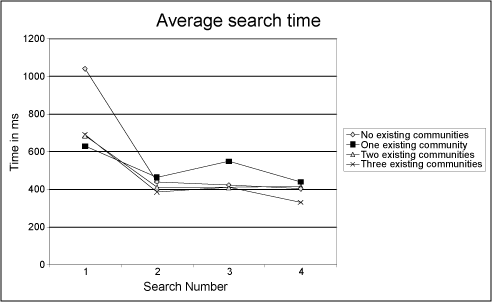 |
In Figure 9, four searches were performed in the
Fruitfly community and the time for results to return recorded.
The same four searches were performed within the community in the
presence of between one and three other communities (each with
about 100 files). The first of the searches took about twice as
long without the presence of other communities than with, but the
subsequent three searches took about the same time regardless of
the number of communities. This indicates that search times
converge more quickly than publish times and that the existence of
other communities does not affect search times.
A permanent U-P2P server has been set up
(http://24.102.27.174:3300/up2p) and the Fruitfly gene
annotations have been published there. In addition three other
collections of XML documents have been published:
- DBLP [26] - references to Computer Science related papers, theses and proceedings
- EDGAR [27] - filings with the US Securities and Exchange Commission (SEC)
- Gene Ontology [28] - database of gene-related concepts
These are all pure XML communities: objects do not contain
embedded objects. A few hundred objects have been published in
each community. These can be searched by accessing the client
running at the permanent location or via a U-P2P peer installed
elsewhere. In addition, Chemistry Markup Language (CML)
researchers also attempted to create a community for sharing
molecules using this server.
In general these preliminary performance results indicate that
base performance is a general problem: publish times of 1s on a
Pentium 4 are too slow. However, the quick convergence of publish
and search times, their slow linear growth as the number of files
increase and practical experience indicate that a U-P2P node is
scalable and can accommodate a few thousand files before becoming
too slow to be useful. One approach to remedying this problem
would be to upgrade to the latest version of XML:DB which promises
performance enhancements. Another option would be to use the file
system for storing documents although this makes rich search more
difficult. One concrete improvement is the ability to designate
other nodes to be central servers for new communities. This
offloads requests as well as storage space allowing the network as
a whole to serve many more objects.
U-P2P is a peer-to-peer framework that allows a user to describe,
share and discover communities just like any other resource. Once
a community is found, its schema and associated stylesheets are
downloaded and are used to perform search and publishing of
resources specific to that community. Communities play a
generative role similar to metaclasses in object-oriented
languages. Possible applications of U-P2P include sharing
resources such as resumes, knowledge management in a corporate
setting, or distributed repositories for design patterns and
software components.
A major direction for future work is in demonstrating the protocol
independence of U-P2P. By developing PeerNetworkAdapters to
interface to existing networks such as Freenet or Gnutella, U-P2P
could become a meta-data layer that would provide an enhanced
community-based search capability.
U-P2P communities may also be extended beyond the schema format to
include definition of parameters such as protocol, security and
authentication. These various parameters define a design space for
peer-to-peer systems. Instead of envisioning a single system that
is all things to all people, a more practical approach is to
consider which methods are most appropriate to the application.
The system should allow important features such as security or
authentication to be decoupled and mixed and matched.
Despite some database performance issues that we believe can be
overcome, as it stands U-P2P can be easily used for distributed
sharing of XML documents, while exploiting structured metadata to
optimize search.
U-P2P is an open source application licensed under the GPL, and
makes use of other open source products such as Jakarta Tomcat
[16] and eXist [18]. Complete source code and
documentation as well as guides and presentations are accessible
at http://u-p2p.sourceforge.net.
This work is supported by the Natural Sciences and Engineering
Research Council of Canada and the Foundry Program of Carleton
University. Valuable feedback on U-P2P has been received from Peter
Murray-Rust and his team at the University of Cambridge, UK.
The design pattern case study would not have been possible
without the help of Darrell Ferguson and Dwight Deugo of
the Carleton School of Computer Science.
-
- 1
- Napster, http://www.napster.com Accessed on 07 April 2003 06:00 UTC.
- 2
- Gnutella, http://gnutella.wego.com Accessed on 07 April 2003 06:00 UTC.
- 3
- Thadani, Sumeet,
Meta Information Searches on the Gnutella Network,
http://www.limewire.com/index.jsp/metainfo_searches Accessed on 07 April 2003 06:00 UTC.
- 4
- Thadani, Sumeet,
Meta Data searches on the Gnutella Network (addendum),
http://www.limewire.com/developer/MetaProposal2.htm Accessed on 07 April 2003 06:00 UTC.
- 5
- FastTrack, now owned by Sharman Networks and found in
Kazaa Media Desktop http://www.kazaa.com Accessed on 07 April 2003 06:00 UTC.
- 6
- OpenCola project, http://www.opencola.com Accessed on 07 April 2003 06:00 UTC.
- 7
- Bitzi, http://www.bitzi.com Accessed on 07 April 2003 06:00 UTC.
- 8
- XML Schema Part 0: Primer, W3C Recommendation, 2
May 2001 http://www.w3.org/TR/xmlschema-0/ Accessed on 07 April 2003 06:00 UTC.
- 9
- Tim Bray, Jean Paoli, C. M. Sperberg-McQueen, Eve Maler, Extensible
Markup Language (XML) 1.0 (Second Edition), W3C Recommendation, 6
October 2000, http://www.w3.org/TR/REC-xml Accessed on 07 April 2003 06:00 UTC.
- 10
- Resource Description Framework, W3C http://www.w3.org/RDF/ Accessed on 07 April 2003 06:00 UTC.
- 11
- Tim Berners-Lee, James Hendler and Ora Lassila,
The Semantic Web, Scientific American, May 2001.
- 12
- Nejdl, Wolfgang et al, EDUTELLA: A P2P Networking
Infrastructure Based on RDF,
http://edutella.jxta.org/reports/edutella-whitepaper.pdf Accessed on 07 April 2003 06:00 UTC.
- 13
- Extensible Stylesheet Language Transformations (XSLT) Version 1.0,
W3C Recommendation, 16 November 1999, James Clark (Editor),
http://www.w3.org/TR/xslt Accessed on 07 April 2003 06:00 UTC.
- 14
- Gong Li, JXTA: A Network Programming
Environment, IEEE Internet Computing Vol 5. No. 3. May/June 2001
- 15
- JavaServer Pages, Sun Microsystems, http://java.sun.com/products/jsp/ Accessed on 07 April 2003 06:00 UTC.
- 16
- Jakarta Tomcat, Apache Software Foundation, http://jakarta.apache.org/tomcat Accessed on 07 April 2003 06:00 UTC.
- 17
- XML:DB API, Working Draft, 20 September 2001, Kimbro Staken (Editor),
http://www.xmldb.org/xapi/xapi-draft.html Accessed on 07 April 2003 06:00 UTC.
- 18
- eXist 0.8, http://exist.sourceforge.net Accessed on 07 April 2003 06:00 UTC.
- 19
- The SSL Protocol Version 3.0, Internet-Draft, 18 November 1996,
http://wp.netscape.com/eng/ssl3/draft302.txt Accessed on 07 April 2003 06:00 UTC.
- 20
- XML-Signature Syntax and Processing, W3C Recommendation, 12 February 2002,
http://www.w3.org/TR/xmldsig-core/ Accessed on 07 April 2003 06:00 UTC.
- 21
- Dwight Deugo, Darrell Ferguson, Carleton Pattern
Repository, http://muffin.nexus.carleton.ca/~darrell/repo/ Accessed in July 2002.
- 22
- Dwight Deugo, D. Ferguson, XML Specification for Design Patterns,
Proceedings of the Second International Conference on
Internet Computing (IC'2001): 407-412.
- 23
- Neal Arthorne, An XML Schema for Design
Patterns,
http://chat.carleton.ca/~narthorn/project/patterns/pattern.xsd Accessed on 07 April 2003 06:00 UTC.
- 24
- G.M. Rubin, Around the Genomes: The Drosophila Genome Project,
Genome Research (1996) 6:71-79
- 25
- DTD2XS,
http://puvogel.informatik.med.uni-giessen.de/lumrix/ Accessed on 07 April 2003 06:00 UTC.
- 26
- DBLP, http://dblp.uni-trier.de/xml/ Accessed on 07 April 2003 06:00 UTC.
- 27
- EDGAR, http://bulk.resource.org/edgar/xml/ Accessed on 07 April 2003 06:00 UTC.
- 28
- The Gene Ontology Consortium, Gene Ontology: tool for the unification of biology
Nature Genetics 25: 25-29.
This paper was originally published in the
Proceedings of the
USENIX Annual Technical Conference (FREENIX Track),
June 9 – 14, 2003,
San Antonio, TX, USA
Last changed: 3 Jun 2003 aw
|
|
| 